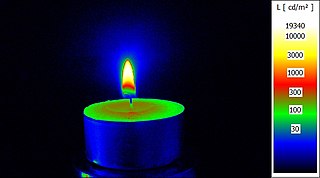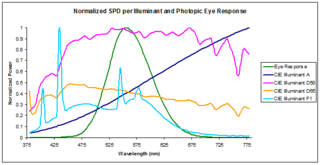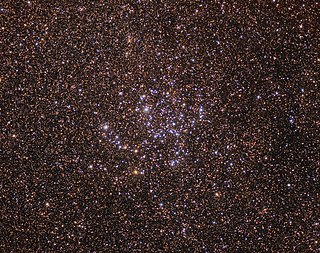
Apparent magnitude is a measure of the brightness of a star or other astronomical object to an observer on Earth. An object's apparent magnitude depends on its intrinsic luminosity, its distance, and any extinction of the object's light caused by interstellar dust along the line of sight to the observer.

Luminance is a photometric measure of the luminous intensity per unit area of light travelling in a given direction. It describes the amount of light that passes through, is emitted from, or is reflected from a particular area, and falls within a given solid angle.
The molecular mass (m) is the mass of a given molecule. The unit dalton (Da) is often used. Different molecules of the same compound may have different molecular masses because they contain different isotopes of an element. The derived quantity relative molecular mass is the unitless ratio of the mass of a molecule to the atomic mass constant (which is equal to one dalton).
Metric or metrical may refer to:
Verification or verify may refer to:

In astronomy, photometry, from Greek photo- ("light") and -metry ("measure"), is a technique used in astronomy that is concerned with measuring the flux or intensity of light radiated by astronomical objects. This light is measured through a telescope using a photometer, often made using electronic devices such as a CCD photometer or a photoelectric photometer that converts light into an electric current by the photoelectric effect. When calibrated against standard stars of known intensity and colour, photometers can measure the brightness or apparent magnitude of celestial objects.
pH is a measure of acidity or alkalinity.
Colorimetry is "the science and technology used to quantify and describe physically the human color perception". It is similar to spectrophotometry, but is distinguished by its interest in reducing spectra to the physical correlates of color perception, most often the CIE 1931 XYZ color space tristimulus values and related quantities.

Photometry is a branch of optics that deals with the measurement of light in terms of its perceived brightness to the human eye. It is concerned with quantifying the amount of light that is emitted, transmitted, or received by an object or a system.
Television ratings may refer to:

In radiometry, photometry, and color science, a spectral power distribution (SPD) measurement describes the power per unit area per unit wavelength of an illumination. More generally, the term spectral power distribution can refer to the concentration, as a function of wavelength, of any radiometric or photometric quantity.
The Bright Star Catalogue, also known as the Yale Catalogue of Bright Stars, Yale Bright Star Catalogue, or just YBS, is a star catalogue that lists all stars of stellar magnitude 6.5 or brighter, which is roughly every star visible to the naked eye from Earth. The catalog lists 9,110 objects, of which 9,095 are stars, 11 are novae or supernovae, and four are non-stellar objects which are the globular clusters 47 Tucanae and NGC 2808 (HR 3671), and the open clusters NGC 2281 (HR 2496) and Messier 67 (HR 3515).
Several measures of light are commonly known as intensity:
Mesopic vision, sometimes also called twilight vision, is a combination of photopic and scotopic vision under low-light conditions. Mesopic levels range approximately from 0.01 to 3.0 cd/m2 in luminance. Most nighttime outdoor and street lighting conditions are in the mesopic range.

The UBV photometric system, also called the Johnson system, is a photometric system usually employed for classifying stars according to their colors. It was the first standardized photometric system. The apparent magnitudes of stars in the system are often used to determine the color indices B−V and U−B, the difference between the B and V magnitudes and the U and B magnitudes respectively.

NGC 3114 is a sparse open cluster which is projected onto the outskirts of the Carina complex.

Xuntian, also known as the Chinese Space Station Telescope (CSST) is a planned Chinese space telescope currently under development. It will feature a 2-meter diameter primary mirror and is expected to have a field of view 300–350 times larger than the Hubble Space Telescope. This will allow the telescope to image up to 40 percent of the sky using its 2.5 gigapixel camera over ten years.

ASTERIA was a miniaturized space telescope technology demonstration and opportunistic science mission to conduct astrophysical measurements using a CubeSat. It was designed in collaboration between the Massachusetts Institute of Technology (MIT) and NASA's Jet Propulsion Laboratory. ASTERIA was the first JPL-built CubeSat to have been successfully operated in space. Originally envisioned as a project for training early career scientists and engineers, ASTERIA's technical goal was to achieve arcsecond-level line-of-sight pointing error and highly stable focal plane temperature control. These technologies are important for precision photometry, i.e., the measurement of stellar brightness over time. Precision photometry, in turn, provides a way to study stellar activity, transiting exoplanets, and other astrophysical phenomena.
This page is based on this
Wikipedia article Text is available under the
CC BY-SA 4.0 license; additional terms may apply.
Images, videos and audio are available under their respective licenses.








